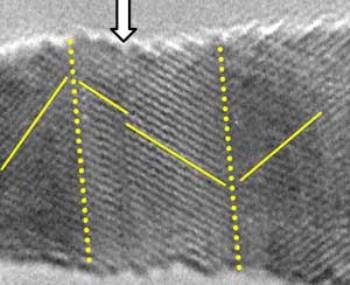Researchers from the Rice University have discovered that thin gold wires having less than 20 nm width exhibit twinning and brittle-like fractures under tensile loading or stress.
 A single crystal nanowire shows evidence of twinning under tensile loading in this electron microscope image.
A single crystal nanowire shows evidence of twinning under tensile loading in this electron microscope image.
A research paper released by Jun Lou, material scientist at Rice University, has revealed microscopic detail of changes that nanowires undergo during stress.
Rice researchers’ technique offers a way for the industry to observe how nanowires made of platinum, palladium, tellurium, silver and gold have application opportunity in the future nanoelectronic devices.
Gold is an extremely ductile material and it can be stretched. However, the current study shows that at the nano level gold is not ductile.. When the material is stressed in a different manner, a defect called twin can be formed. When observed under an electron microscope, twin effects are seen as dark lines in the nanowires. As the material under research is not precisely brittle, it fractures with less or no ductility. Hence, it is called as brittle-like fractures.
Researchers conducted studies on 22 gold nanowires. Twins became visible under shear force, which strained atoms to shift to the surface defect location and initiated nanoscale damage across the wire. The study results are critical to manufacturers who have planned to use gold as a nanomechanical component.